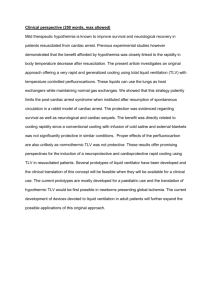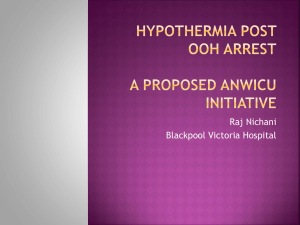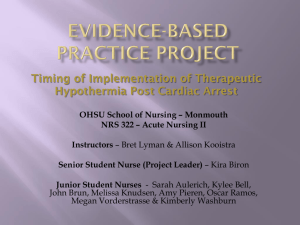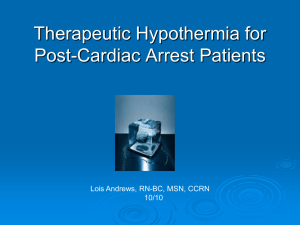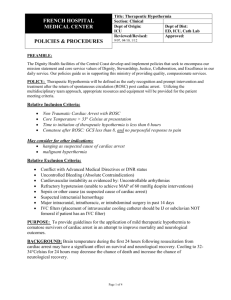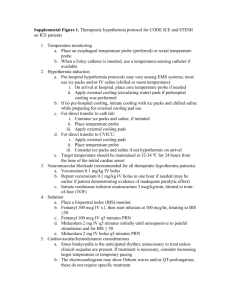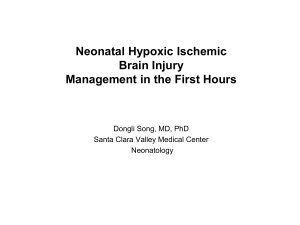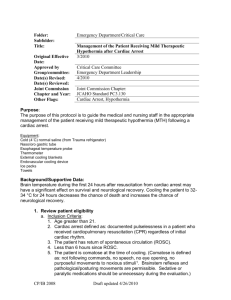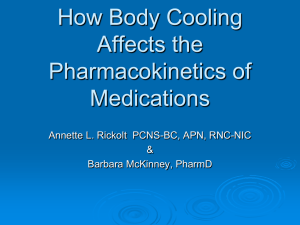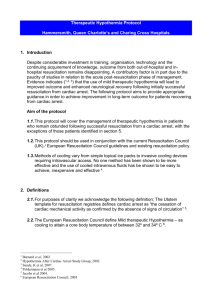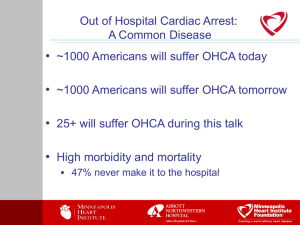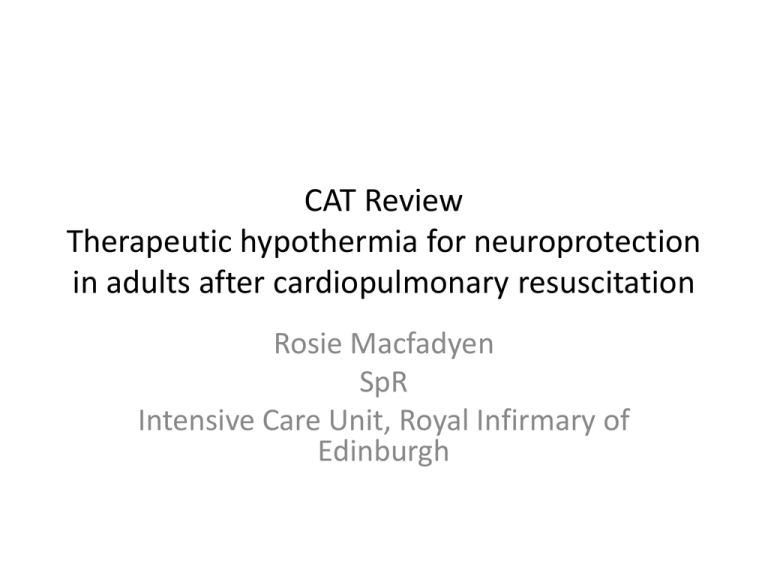
CAT Review
Therapeutic hypothermia for neuroprotection
in adults after cardiopulmonary resuscitation
Rosie Macfadyen
SpR
Intensive Care Unit, Royal Infirmary of
Edinburgh
Citation
• Arrich J, Holzer M, Herkner H, Mullner M.
Hypothermia for neuroprotection in adults
after cardiopulmonary resuscitation. Cochrane
Database of Systematic Reviews 2009, Issue 4
Art no.: CD004128
Three part clinical question
• Patients:
– Adult patients who have suffered cardiac arrest –
> 18y, in or out of hospital
• Intervention:
– Mild therapeutic hypothermia
– <35°C, regardless of method of T° reduction, applied
within 6h of arrival at hospital
• Outcome:
– Neurological recovery – best neurologic outcome
during hospital stay.
The rationale
• Prevention of postresuscitation syndrome
– ↑ CPP – restores energy stores to neurons
– But also triggers harmful chemical cascades - ↑
reactive oxygen species, catecholamines,
glutamate, dopamine.
– BBB disruption
– Multifocal damage to brain.
The rationale
• Aims to preserve neurological function in pts
comatose post cardiac arrest
• TH may influence several damaging pathways
simultaneously, in addition to ↓ CMRO2
• Inhibition of catecholamine/dopamine/free radical
release.
• Preservation of BBB
• Preservation of cerebral microcirculation
• Preservation ATP stores
Primary Outcome
• Neurological recovery – best neurological
outcome during hospital stay.
• Graded as ‘good’ if Cerebral Performance
Category 1-2
• Secondary outcomes
– Survival to hospital discharge
– Survival at 6 months
– Long-term dependency
– Cost effectiveness
• Examination of adverse events
Measure of effect
• Relative risk of achieving good neurological
recovery in patients allocated to hypothermia
compared to those not receiving hypothermia
at hospital discharge
Study selection
• Limited to randomised and ‘quasi-randomised’
trials on adult patients remaining comatose after
cardiac arrest.
• 5 trials met criteria – 481 patients in total
– HACA NEJM 2002 ‘the European one’- 275 pts
– Bernard NEJM 2002 ‘the Australian one’ – 77 pts
– Hachimi-Idrissi Resuscitation 2001 – 33 pts
– Laurent J Am Coll Cardiol 2005 – 42 pts
– Mori Crit Care Med 2000 - 54
Clinical heterogeneity
• 3/5 trials ‘conventional cooling methods’
• Duration of cooling variable; 3-72h
• Laurent – high-volume haemofiltration
200ml/kg/hr
• Mori – unclear cooling method
• These two study analysed separately – effect not
pooled with other studies.
Risk of Bias
• Mode of randomization, allocation concealment
– 3/5 adequate – HACA, Hachimi-idrissi, Laurent
• Level of blinding at follow-up
– 3/5 adequate – Bernard, HACA, Hachimi-Idrissi
• Loss to follow-up
– HACA – lost 2/275 patients
• Comparability of groups
– HACA – some baseline differences between groups – adjusted for.
– Bernard – differences in sex/rate of bystander CPR between groups – not
adjusted for
– Mori- no information on baseline characteristics of patient groups
Neurological outcome: cooling vs no
cooling
Survival to discharge: cooling vs no
cooling
Secondary outcomes
• Survival at 6 months and long-term
– No data on this outcome
• Quality of life and long-term dependency
– No data on this outcome
• Cost effectiveness
– No data on this outcome
Subgroup analyses
• Likely to benefit
– OOHCA – 4/5 looked only at OOHCA
– Presumed cardiac aetiology
– VF/VT
• Unable to ascertain benefit
– In hospital cardiac arrest
– Asystole as presenting rhythm
– Non-cardiac causes of arrest
Adverse events
• No statistically significant differences in events
in cooled vs non-cooled
–
–
–
–
–
–
–
–
–
Bleeding
Pneumonia
Sepsis
Pancreatitis
Renal failure/need for RRT
Pulmonary oedema
Seizures
Lethal arrhythmias
Hypocalcaemia/hypophosphataemia
12 EBM Questions
• Do the methods allow accurate testing of the
hypothesis? - Yes
• Do the statistical tests correctly test the
results to allow differentiation of statistically
significant results? - Yes
• Are the calculations valid in the light of the
results? -Yes
• Did any results get omitted and why?
– Extracorporeal cooling/unclear cooling methods
• Did they suggest any other areas of research?
– Need further data before supporting therapeutic
hypothermia in; in-hospital arrests, asystole, non-cardiac
aetiology
– Optimal cooling protocol
• Did they make any recommendations based on the
results and were they appropriate?
– Conventional cooling post-arrest seems to improve
survival. Reviewers findings support current ILCOR
guidelines
• What level of evidence does the study represent? 1+/1-
• What grade of recommendation can I make on this
result alone? A
• Is the study relevant to my clinical practice? Yes
• What grade of evidence can I make when this
study is considered along with other available
evidence? A
• Should I change my practice because of these
results? Yes
• Should I audit my current practice because of
these results? Yes
Citation
ArrichJ, Holzer M, Herkner H, Mullner M.
Hypothermia for neuroprotection in adults
after cardiopulmonary resuscitation. Cochrane
Database of Systematic Reviews 2009, Issue 4
Art no.: CD004128
SHAMELESS PLUG
Scottish Intensive Care Society
Education Meeting
Monday 25th and Tuesday 26th October 2010
Royal College of Physicians
Edinburgh
Approved for 10 CPD points !
http://www.scottishintensivecare.org.uk/meetings/index.htm
For programme and application form

